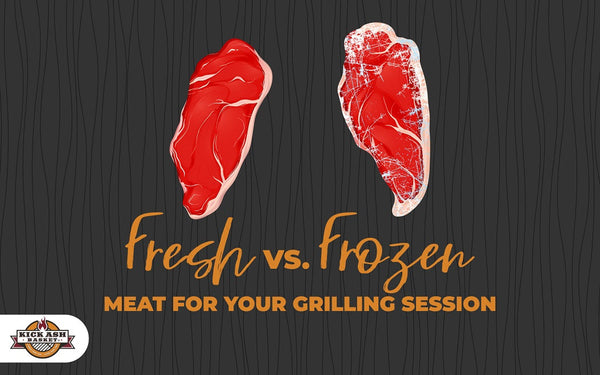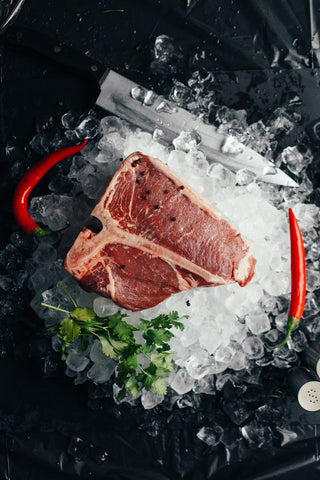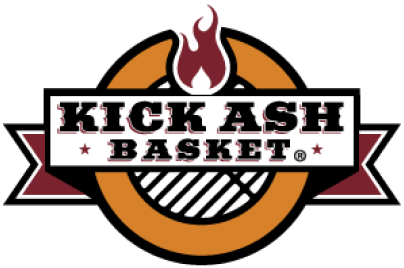
Fresh vs. Frozen Meat for Your Grilling Session
In the age of convenience, frozen foods are almost necessary. Now you can come home late from a busy day at the office and grill up a frozen steak in less than 45 minutes. No planning required, and a happy belly. Some of the frozen foods are better than “fresh” meat! For example, some fish can sit at meat markets for up to three weeks. But frozen fish come straight from the ocean into the blast freezer, and still have outstanding flavor! So let’s compare fresh and frozen meat, and see which is right for your dinner table.
Faceoff: Fresh Meat and Frozen Meat
Drumroll, please! The winner: fresh meat, by a landslide! Of course, fresh is better. Why? Fresh meat (if it is truly fresh) has the most nutrients. So let’s look at the reasons frozen meat usually “can’t take the heat” against fresh. We will also walk you through steps you can take to maximize the quality of your frozen food. If you take care of frozen meat properly, sometimes it can be even better than fresh. Here’s why frozen meat usually doesn’t measure up to fresh:
- Difficult thawing process
- More difficult to cook
- Flavor loss
- Meat quality degrades
- Nutrient loss
Difficult Thawing Process
Frozen foods often take a day or more to thaw in the fridge. Large cuts of meat take even longer. If you don’t have that kind of time, it can be a hassle. You also have to make sure not to leave meat at room temperature for too long. This creates a breeding ground for bacteria and could cause someone to get sick.
More Difficult to Cook
Frozen meat is often undercooked because the exterior is misleading. It might look done, but when you cut it open, it can still be raw inside. Frozen meat usually takes about 50% longer to cook than fresh meat. For this reason, it is extremely important to use a thermometer. Another common problem is overcooking the outside. This is due to how long it takes the inside to come up to temperature. You have to be mindful of how long the meat stays on direct heat.
Flavor Loss
When you freeze meat, sharp crystals of ice are formed. This causes the fibers to break down, and some of the natural flavors escape once thawed. This happens especially with meat that has been in the freezer for a long time and has degraded in quality.
Meat Quality Degrades
Freezer burn can cause discoloration of the meat. It can also dry it out. While it is still safe to eat, it is better to discard the discolored pieces. As a rule of thumb, try not to keep any meat in the freezer for longer than four or five months.
Nutrient Loss
The older food gets, the more nutrition it loses. To avoid this, freeze food while it is at its freshest. Also be sure to pack it efficiently. When frozen carefully, it can even be more nutrient-rich than a fresh cut that has been sitting for a few days. There are some general guidelines for keeping frozen meat at its highest quality, which we’ll outline for you below.
How You Treat Meats in the Freezer Makes a Difference
Proper Freezing Techniques
The absolute best way to freeze your meat is to have it vacuum-packed. It is also advisable to bring it to a very low temperature quickly, such as with a blast freezer. When meat is frozen rapidly, fewer ice crystals can develop, which means less moisture loss upon thawing.
Okay okay, so that is great and all, but what about for the everyday home cook? The best way to ensure meat quality is to lay it flat on a parchment-lined sheet pan, then put it directly in the freezer. Leaving the meat uncovered as it freezes will allow any moisture to evaporate. This means it will be drier, and dry steaks sear better. Freeze it until the next morning, then wrap tightly. Even double wrap it-- you don’t want any air touching the meat.
Proper Thawing Techniques
Meat should be thawed as slowly as possible. The best way to do this is to put frozen meat in the fridge for one to two days before you cook it. You can also put it in a cold water bath while it hangs out in the fridge. Do not use hot water! This starts the cooking process, which you don’t want. Never thaw meat at room temperature! Another option is using your microwave’s defrost feature. Just be sure not to start cooking it while it’s in there.
On Refreezing
The USDA approves refreezing meat, but within reason. For instance, if you have safely thawed the meat in the fridge and decide not to cook it after all, you can refreeze it. A good rule of thumb is that you do not refreeze any meat that has been left at normal room temperature for over 2 hours. Just remember, though, that every time you thaw and refreeze meat, the quality suffers!
Can I Grill Frozen Meat?
This is a common question asked by grillers. The situation usually comes up when the weather is nice, your friends are over, and you spontaneously decide to break out the grill. Unfortunately, you don’t have the time to grab some fresh meat. You do have meat in the freezer, though, that is nowhere near ready to be served. Well, you are in luck! Get your grill started because you most definitely can cook meat from frozen. In some cases, it might even be better than if you had thawed it! These same principles can apply whether you are grilling quickly or experimenting with how to smoke meat with a charcoal grill. We will now go over how to grill each variety of commonly-frozen meat.

Photo by Victoria Shes on Unsplash
How to Grill Frozen Meat
Steaks
Surprisingly, a lot of cooks prefer cooking steaks from frozen. This is because thawing the meat causes some of the moisture to be lost and no one wants that. If the steak is still frozen, the moisture stays on the inside as it is cooking. Thawed meat can easily overcook in the middle and cooking from frozen makes that far less likely. You can also slow smoke and cook a steak at 250-275 grill temp and bring the internal temp up very slowly while lastly searing the meat after getting to the desired internal temp to get a crust at the end.
Preferably, the steak should be about 1 to 1½ inches thick. Although thinner steaks do thaw quicker, they tend to overcook. That’s because the inside thaws fast while the outside hasn’t had enough time to get a good sear.
Start the steaks off on the grill with direct heat (500 to 700°F) until they are nicely seared. This should take about five to seven minutes. The internal temperature should be between 70 and 90°F. You can season the steaks at this point, due to seasonings not sticking to frozen meat. Next, move the steaks over to indirect heat (300 to 350°F) to slowly cook them to perfection. Remember that cooking from frozen will take a little more time. The steak should take between 10 to 15 minutes on indirect heat. Finally, let them rest for five minutes. Here are pull temperatures according to doneness:
- Rare: Pull at 115-120°F for a 120-125°F final temperature.
- Medium rare: Pull at 120-125°F for a 125-130°F final temperature.
- Medium: Pull at 130-135°F for a 135-140°F final temperature.
- Medium well: Pull at 140-145°F for a 145-150°F final temperature.
- Well done: Pull at 150°F+ for a 155°F+ final temperature.
Burgers
There isn’t a lot of difference between cooking a thawed or frozen burger. The main difference is that frozen burger patties can take 50% longer to cook. If you are having trouble separating your frozen burger patties, leave them out for a few minutes. Then you can stick a butter knife in between and pry them apart. The ideal cooking temperature for frozen burgers should be about 325°F. After placing your seasoned patties on the grill, flip after five minutes. Continue to flip every five minutes until the internal temperature reads 160°F.
Spice up your meal with some weird burger toppings and enjoy!
Chicken
Keep in mind that frozen chicken will take 50% more time to cook! Get frozen chicken breasts out about 30 minutes ahead of time. Your grill should be pre-heated and ready to go at about 375 to 450°F. Season your chicken, and throw the pieces on the grill. Cook for about seven to eight minutes on each side, or until the internal temperature reaches 160 to 165°F. Throw the finished product in a delicious grilled chicken salad, and call it a day!
Pork Chops
Pork chops also take up to 50% more time to cook when frozen. You can still grill them up as usual with no changes except cooking time. Get frozen chops out 30 minutes ahead of time. Season the meat before you put it on the preheated grill. The internal temp should read 145 to 160°F, depending on your preference. Rest the pork chops for three minutes before serving.
Shrimp
Frozen shrimp works well on the grill! It is so easy to buy a bag of IQF shrimp rather than scour a fish market for fresh shrimp. You can easily get out a handful of shrimp from the freezer on a whim. You only need 15-30 minutes for them to thaw a bit, and then you can slide them on skewers. If using bamboo skewers, be sure to soak the skewers in water for 15 minutes to prevent them from burning on the charcoal grill. Use a basting brush to spread butter and seasonings on the shrimp. Turn the skewers, and repeat on the other side. Cook the shrimp on the preheated grill at 350 to 450°F for three to four minutes on each side. If you like your shrimp a bit crispier, add two minutes on each side.
Salmon
Frozen salmon should be in an airtight container with no visible frost. If freezing salmon on your own ahead of time, season the salmon before you freeze it. This will intensify the flavors when the salmon is grilled. Keep the skin on to prevent the salmon from curling while it grills. The grill should be about 375°F. Place the salmon skin-side-up on the grill. Season the salmon now if you didn’t do it before freezing. For a ½-inch thick salmon, grill for three to four minutes on each side. For a 1-inch thick salmon, grill for six to eight minutes per side.
We hope you are now a little more familiar with the benefits of both fresh and frozen meat. Not only do frozen foods make your life a little easier, but so does our Kick Ash Basket! Try it today.

